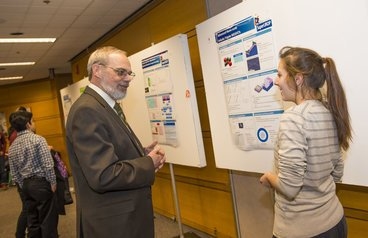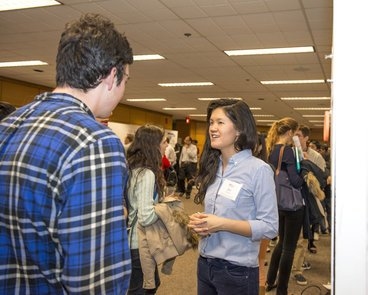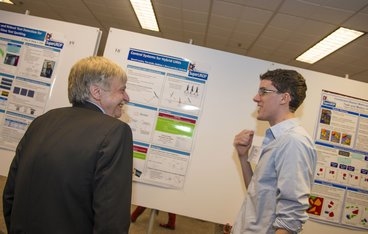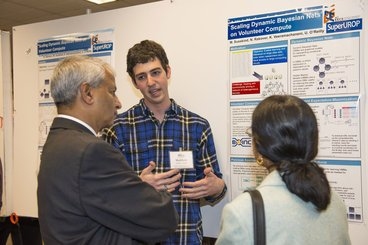On Dec. 5, Paul Bassett ’85 traveled to Cambridge from Austin, Tex., where he works as a senior director of technology for the wireless communications giant Qualcomm. He wound his way through a crowd assembled in the Grier Room at MIT, where nearly 80 undergraduates in electrical engineering and computer science (EECS) presented posters on cutting-edge research projects. Qualcomm sponsors several of those students as part of the MIT SuperUROP program.
Under the leadership of EECS department head Anantha P. Chandrakasan, the Joseph F. and Nancy P. Keithley Professor of Electrical Engineering, and MIT’s Undergraduate Research Opportunities Program, SuperUROP launched last year as a way to offer undergraduates a deep dive into research.
SuperUROP pairs students with a faculty member for an entire academic year and includes a two-semester course on undergraduate research. Participants expect to produce prototypes or publication-worthy results, and their projects often evolve into graduate theses, startup plans, or industry positions.
“Here is a group of top-notch engineering students working in all sorts of different areas,” Bassett said. “I can scan through the projects and identify the ones that align with what the company’s going to care about in the future. As an engineering manager, my goal is the future engineers as much as the actual research. Qualcomm wants MIT to be working on interesting research that will be applicable to future products — but MIT is also going to be turning out the engineers who are going to help us build those products.”
SuperUROP brings students and industry sponsors together in mutually beneficial engagement. In addition to funding projects through the Research and Innovation Scholars Program, sponsors mentor students, give talks about their companies’ technologies, and work with faculty to set research directions. Students, meanwhile, get valuable insight from professionals working on real-world products and services.
“SuperUROP is a tremendous opportunity for students and companies to make connections that foster future innovations and that launch the careers of engineering leaders,” said entrepreneur Desh Deshpande, a member of the MIT Corporation who attended the poster session.
Sowing the seeds for future engineering leaders
Benoit Landry, an EECS senior from Montreal, is sponsored by the automotive technology company DENSO and has enjoyed discussions with several other industry partners of SuperUROP. Under the guidance of Russ Tedrake, an associate professor of computer science and engineering, Landry is developing control systems that could enhance the agility of unmanned aerial vehicles by, for example, allowing a small drone to rapidly change its direction by bouncing off of a wall.
“We can all benefit from Cisco or Qualcomm coming in and giving us a talk, whether they’re directly funding our research or not,” Landry said. At informal dinners with sponsors, he added, “You’ve got a bunch of people who feel very strongly about engineering, sitting around a table and talking about research. It’s very empowering to talk to all these people who are incredibly talented. They come to tell you that what you’re working on is worth working on. It’s a big boost [for the students’] motivation.”
EECS junior Rose Abramson, who is working on technology that could shrink the scale of transistors made from silicon alternatives to below 10 nanometers, said, “People from a lot of different industries come up to you and want to talk about your work because it’s so interesting.” Her sponsor, the semiconductor company MediaTek Inc., has been receptive to the SuperUROP students. “They really like hearing about the work, and they come to many of the events,” said Abramson, who grew up near San Francisco.
The funding Abramson has received through her MediaTek Research and Innovation Scholarship has enabled her to fabricate devices in the clean rooms at MIT’s Microsystems Technology Laboratory (MTL) — an expensive activity that usually isn’t open to undergraduates, but which was made possible through generous support from MTL for the SuperUROP program.
“Most people only start fabricating once they get into graduate school,” said Abramson, whose faculty advisor is MTL director Jesús del Alamo, the Donner Professor of Science. “It’s really cool to be able to actually see how these things are put together.”
“One of my goals is to connect the sponsors’ research interests with faculty, so that the relationship between the faculty and the company can carry forward year over year,” said Ted Equi, a 30-year veteran of the semiconductor industry and the industrial liaison for SuperUROP. “The beauty of this program is that it provides an infrastructure for getting the projects generated. We solicit ideas from industry and from faculty, and then the students write the proposal.”
Collaboration linking industry, faculty and students
EECS junior Qui Nguyen had never thought of working on a smartphone app that monitors a medical disorder before she came across one of Chandrakasan’s research projects while applying for SuperUROP this fall. “I was interested in it because the application is useful and tangible, and it’s an interesting area in computer science,” said Nguyen, who is sponsored by the contract electronics manufacturer Foxconn.
Nguyen and the graduate student on her team aim to create a smartphone app that patients and doctors can use to reliably track vitiligo, a skin condition characterized by white patches where pigment-producing cells have been destroyed. A patient will typically have several affected areas on the body, so Nguyen’s task is to develop an image-processing algorithm that can automatically sort by area the photos that patients take. She hopes the application can extend to tracking other skin conditions as well.
EECS senior Kristjan Eerik Kaseniit’s synthetic biology project was already underway before becoming a SuperUROP. Kaseniit said he is trying to “program biological cells into behaving sort of like robots.” Strands of RNA placed within the cells perform computations that could, for example, detect cancer.
While the project’s results prior to SuperUROP were promising, Kaseniit said, “Now I can really go in-depth. If you’re doing a regular UROP, the commitment is sort of different. But now I go to lab as often as I can, because I’m more invested in this project. The learning curve is exponential — it’s very slow in the beginning, but then it speeds up a lot. I’m gaining momentum, and because I’m able to continue over IAP and the next semester, the momentum’s not lost.”
Kaseniit is considering building upon his SuperUROP, which is sponsored by Draper Laboratory and supervised by associate professor of biological engineering Ron Weiss, in the new 6-7 MEng program after he completes a year of compulsory military service in his native Estonia.
Another EECS senior, David Xiao, is trying to decide whether to go into research or industry after graduation. Sponsored by Quanta Computer, the Brentwood, N.H., native is working with associate professor Rob Miller of the Computer Science and Artificial Intelligence Laboratory to create online games for teaching software engineering. Their goal is to deploy the games in the spring edX class 6.005x (Elements of Software Construction).
“SuperUROP offers an interesting balance of research and industry,” Xiao said. “Andreesen Horowitz venture capitalist Peter Levine shared some interesting insights about how startups work. There are [students] here who probably won’t end up doing research. Either way, the program is useful.”
MIT Chancellor Eric Grimson, the Bernard Gordon Professor of Medical Engineering, who attended the poster session, agreed with Xiao. “The experiences students obtain by focusing on a cutting-edge research problem over an extended period of time will be invaluable to them no matter what career path they follow,” he said.
Research that's relevant
Over the buzz of the presentations taking place in the Grier Room, John Howard explained why his company became involved with SuperUROP. He is the director of advanced materials development at Lab 126, a consumer electronics subsidiary of Amazon.
“What we’re getting is an opportunity to invest in students and get to know them,” Howard said. “It’s extremely important to us to find the best and the brightest.” In addition, he said, the work the students presented seemed relevant to issues that industry is working on: “They’re actually trying to take [the research] someplace. It’s nice to see.”
In addition to Amazon, Andreesen Horowitz, Cisco, DENSO, Draper Laboratory, Foxconn, MediaTek, Qualcomm, and Quanta Computer, SuperUROP industry sponsors include Actifio, Analog Devices, eBay Inc., Google, Texas Instruments, TIBCO Software Inc., and VMWare. Individual supporters include Robert Fano, Dinarte Morais and Paul Rosenblum, as well as several anonymous donors.
Publication Date:

Caption:
Eric Grimson, MIT chancellor for academic advancement, talks with Rose Abramson, '15, about her work with Jesus del Alamo, director of the Microsystems Technology Laboratories, on developing transistors made with silicon alternatives and sized below 10 nanometers.

Caption:
Qui Nguyen, '15, discusses with another participant her smartphone app that monitors a medical disorder through an image-processing algorithm.

Caption:
Dennis Freeman, MIT dean for undergraduate education and instructor for a SuperUROP class, talks with Benoit Landry, '14, about his work developing advanced agility for unmanned aerial vehicles, supported by the automotive technology company DENSO.

Caption:
Entrepreneur and MIT trustee Desh Deshpande (left) listens to Matt Susskind, '15, a VMware Undergraduate Research and Innovation Scholar, explain his work with CSAIL principal researcher Una May O’Reilly on best online learning practices in building MOOCs.





